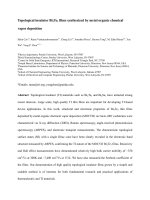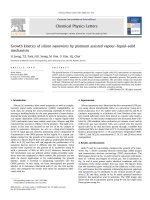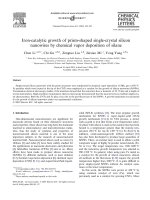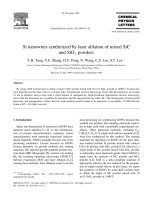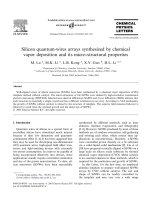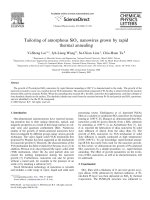- Trang chủ >>
- Khoa Học Tự Nhiên >>
- Vật lý
structure of alumina nanowires synthesized by chemical etching
Bạn đang xem bản rút gọn của tài liệu. Xem và tải ngay bản đầy đủ của tài liệu tại đây (1.74 MB, 7 trang )
Physica E 36 (2007) 140–146
Structure of alumina nanowires synthesized by chemical etching of
anodic alumina membrane
J.K. Han
a
, J. Kim
a
, Y.C. Choi
a
, K S. Chang
b
, J. Lee
c
, H.J. Youn
c
, S.D. Bu
a,Ã
a
Department of Physics, Research Institute of Physics and Chemistry (RINPAC), Chonbuk National University, Jeonju 561-756, Korea
b
Department of Chemistry, Korea Air Force Academy, Cheongwon 363-840, Korea
c
Jeonju Center, Korea Basic Science Institute, Jeonju 561-756, Korea
Received 7 December 2005; received in revised form 27 September 2006; accepted 2 October 2006
Available online 13 November 2006
Abstract
We report the structure of alumina nanowires (ANWs) synthesized by the chemical etching of an anodic alumina membrane (AAM).
The AAM was prepared by the two-step anodization method followed by the lift-off process. The field emission transmission electron
microscopy analyses showed that the AAM consists of a gel-like structure, an outer layer, and an inner layer, which are distinguished by
their anion impurity concentration. The fabricated ANWs appeared to have a two-oxide-layer structure, similar to the core-shell
structure in a coaxial cable. The inner oxide layer may be composed of relatively pure alumina and the outer oxide layer of the
byproducts of the reaction between alumina and the anodization or etching solution. The fabricated ANWs have a flexible nature, with
some of them being sufficiently malleable to form L-shaped ANWs. One possible formation process of the two-oxide-layer structured
ANW is discussed.
r 2006 Elsevier B.V. All rights reserved.
PACS: 77.84.Dy; 81.20.Fw
Keywords: Alumina nanowires; Anodic alumina membrane; Two-oxide-layer structure
1. Introduction
Alumina nanowires (ANWs) have become an exciting
field of study because their large surface area and highly
electropositive surface make them to be an ideal candidate
for water purification filter technology [1].Theyrapidly
absorb dissolved heavy metals including mercury, gold,
silver, cadmium, lead, and uranium. Their highly electro-
positive surface attracts and retains the pathogens and
viruses present in water, which are principally electronega-
tive as a result of the difference in electrical potential
between the water and the particle phase [2]. In addition, the
flow capacity of ANW-based filters is several orders of
magnitude greater than that of alumina membrane filters. A
major challenge is to synthesize high aspect-ratio ANWs
with a uniform and smaller diameter, in order to maximize
the density of the positively charged sites, and to immo-
bilize them into the non-woven filters for improved adapt-
ability.
The simple chemical etching of an anodic aluminum oxide
membrane (AAM) is considered to be an easy and cost-
effective way to fabricate ANWs with high aspect ratios [3].
In our previous work [4], we proposed a possible mechanism
of formation of ANWs produced by the droplet chemical
etching process. Our previous observation revealed that the
mechanism of formation of ANWs could be explained by
the different etching rates of the various oxide layers of the
AAM, as determined by their anion impurity concentration.
In this work, we report the structure of ANWs synthesized
by the chemical etching of an AAM.
2. Experimental procedure
AAMs were fabricated using the two-step anodization
method and subsequent lift-off process by applying a
ARTICLE IN PRESS
www.elsevier.com/locate/physe
1386-9477/$ - see front matter r 2006 Elsevier B.V. All rights reserved.
doi:10.1016/j.physe.2006.10.003
Ã
Corresponding author. Tel.: +82 63 270 4264; fax: +82 63 270 3320.
E-mail address: (S.D. Bu).
saturated HgC l
2
solution [5]. A pure aluminum sheet
(99.999%) is degreased in acetone and electropolished at a
voltage of 20 V and a temperature of 5 1C under stirring.
The electropolished aluminum sheet is then anodized in a
0.3 M oxalic acid at a voltage of 40 V for 12 h at 5 1C. In
order to remove the irregular porous oxide layer formed
during the first anodization, it is etched in an aqueous
mixture solution of phosphoric acid (6 wt%) and chromic
acid (1.8 wt%). The subsequent second anodization, which
is performed under the same conditions as the first
anodization but with a different period of time depending
on the desired thickness of the oxide layers, yields a highly
ordered hexagonal nanopore array of anodic aluminum
oxide on aluminum, i.e. an AAO template. A saturated
HgCl
2
solution is then applied to separate the AAM from
the AAO template. The separated AAM is rinsed with de-
ionized water several times. Finally, an additional pore
widening process is conducted in 5 wt% phosphoric acid at
30 1C in order to obtain the desired pore diameter.
Prior to the droplet chemical etching, the AAM is
annealed at 650 1C to remove the hydroxyl groups (OH
À
)
[6]. The annealed AAM is attached to double-sided Ca tape
on a Pt-coated silicon substrate to hold the ANWs during
the etching process and to prevent the electron charging
phenomenon during the field emission scanning electron
microscopy (FESEM) observation. 0.1 ml of an aqueous
NaOH or H
3
PO
4
solution is applied to the surface of the
AAM for 10 min using a micropipette. The etched AAM is
rinsed several times with de-ionized water and ethanol, and
dried overnight at 70 1C prior to the FESEM observation.
3. Results and discussion
AAMs with suitable pore diameters ranging from 20 to
100 nm were prepared by adjusting the electrolytes,
anodization time and temperature, applied voltage, and
pore widening treatment. The best quality AAM was
obtained using 0.3 M oxalic acid as the electrolyte at 40 V,
which corresponds to the optimum anodization conditions
suggested by Masuda et al., [5]. A typical SEM image of an
AAM fabricated by the two-step anodization method is
shown in Fig. 1. The surface view of the AAM in Fig. 1(a)
shows that it has a perfect hexagonal pore distribution
within a domain size of one to two micro meters, which is
separated from neighboring domains having a pore lattice
with a different orientation. Its average pore diameter is
about 60 nm and the inter-pore distance, that is, the
distance from pore to pore, is about 100 nm. The inter-pore
distance could be controlled by adjusting the applied
voltage. Fig. 1 (b) is a cross-sectional view SEM image of
the AAM and it shows the nature of the straight and
parallel nan opore morphology. The thickness of the AAM
could be controlled by varying the second anodization
time. Fig. 1(c) shows an atomic force microscopy (AFM)
image of the AAM. The configuration of the AAM can be
thought of as a pore surrounded by six small hills, which
we call triple points, and are identified by the black circle in
Fig. 1(c). The average diameter of the triple points is about
40 nm and their height is about 2 nm.
AAMs are known to have a duplex structure, which
results from the different degrees of anion contamination
during the anodic anodization [7]. Fig. 1(d) is a field
emission transmission electron microscopy (FETEM)
image showing the duplex structure of an AAM. The
darker gray layer comprising hexagonal cells is the inner
layer and the relatively bright gray layer is the outer layer.
The inner layer is only about 10 nm in thickness, which is a
typical result under the anodization condition of 0.3 M
oxalic acid at 40 V [8]. The two oxide layers are expected to
have different compositions: the inner layer is known to be
composed of relatively pure Al
2
O
3
and the outer layer
contains several othe r elements such as C and H in the case
of oxalic acid based anodization [9]. The scanning trans-
mission electron microscopy (STEM) image in Fig. 1(e)
suggests that the inner layer and the outer layer are indeed
composed of different elements, which can be notice d from
the different contrasts in the image. The white contrast
should represent the inner layer observed in the FETEM
image of Fig. 1(d).
Fig. 1(f) shows a high-resolution TEM (HRTEM) image
of the AAM. It should be noted that this image is quite
different from the one in Fig. 1(d) and shows that the
AAM is composed of three regions. This contradicts the
usual experimental results obtained for AAMs consisting
of two oxide layers [7,8,10]. The inner layer is blurred and
cannot be clearly distinguished from the outer layer. This
can be explained by there being a gradual change of the
anion impurity concentration, rather than a uniform
distribution. The anions that could possibly contaminate
the outer layer in our fabri cation method are C
2
O
4
2À
,
HC
2
O
4
À
,HC
2
O
3
À
,O
2À
,andOH
À
. In fact, Choi et al. [9]
reported that the anions are not uniformly distributed over
the outer layer, but that the concentration of the
contaminating ions is the highest in the middle of the
outer layer, because of the different mobilities of among
such anions. In addition, tube-like configurations can be
observed at the interface between the pores and the outer
layer, as marked by the white arrows in Fig. 1(f). The tube-
like configurations are clearly different in appearance from
the rest of the cells and their lighter contrast suggests that
they are closely related to the gel-like structure Thompson
and Wood [7] proposed.
We found that the droplet chemical etching of the AAM
creates four distinctive regions with respect to the different
surface morphologies on AAM, as shown in Fig. 2,as
compared with the general immersion etching method.
When a droplet of aqueous NaOH solution is applied to
the AAM, a spreading phenomenon occurs because of the
high surface energy of the AAM, while the aqueous NaOH
solution exhibits low surface energy [11,12]. This spreading
phenomenon results in different volumes of aqueous
NaOH solution per unit area on the AAM in the radial
direction, which in turn results in different degrees of
etching in the radial direction. The center region, marked
ARTICLE IN PRESS
J.K. Han et al. / Physica E 36 (2007) 140–146 141
as A, has the highest volume of aqueous NaOH solution
per unit area, so this region would be etched the most.
Most of the ANWs in this region were lying on the Ca tape,
as is usually observed in the general immersion etching
method with a longer etching time [13]. Such an observa-
tion indicates that this region is analogous to that
corresponding to the longer period of etching time in the
general immersion etching method. By scanning outw ard
from the center, in the A–D direction, the degree of etching
can be seen to have been weakened due to the dwindling
volume of aqueous NaOH solution per unit area. In the
edge region of the etched area denoted by D, the nanopores
are slightly widened, so that this region may correspond to
that observed after a very short etching time in the general
immersion etching method. The border region, where the
precursor film of the aqueous NaO H solution woul d be
formed, can be divided into two regions; one showing the
bundles of ANWs (region B), and the other showing the
formation process of the ANWs (region C).
ARTICLE IN PRESS
Fig. 2. Surface view SEM image of an AAM etched by a dilute NaOH
solution, which shows four distinctive regions.
Fig. 1. Microscopic images of a typical AAM: (a) the surface view SEM image, (b) the cross-sectional view SEM image, (c) the surface view AFM image,
(d) the surface view FETEM image, (e) the surface view STEM image, and (f) the surface view HRTEM image.
J.K. Han et al. / Physica E 36 (2007) 140–146142
Fig. 3 shows the serial plane view SEM images obtained
from the C regions in Fig. 2. AAM with distorted
nanopores, indicated by an arrow, is illustrated in
Fig. 3(a), which is considered as the first stage in the
formation of the ANWs. The inset of Fig. 3(a) clearly
shows that the pore diameter of the AAM has been
broadened and that the pore morphology has evolved from
the initially smooth circular pores of the as-prepared AAM
shown in Fig. 1 to one of distorted circles. The distorted
nanopores suggest that the etching behavior of the AAM
by the NaOH solutions is anisotropic. This anisotropic
nature of the etching behavior in the AAM nanopores
becomes manifest in Fig. 3(b), which shows that the
thickness of the thin walls has been further etched, while
the triple points appear less affected by ch emical attack.
The inset of Fig. 3(b) clearly shows that the trip le points
are distinctively noticeable. Fig. 3(c) shows the fabricated
ANWs, whose diameters range from 30 to 40 nm, which is
in accordance with the hill diameter mentioned above.
Since the diameter and length of the ANWs are closely
related to the hill diameter and thickness of the AAM,
respectively, the diameter and length of the ANWs is
controllable by adjusting the physical characteristics of the
AAM that is used.
The FESEM image in Fig. 4 shows the longitudinal view
of a naturally formed ANW bundle, which can be observed
in region B of Fig. 2. The presence of this naturally formed
ANW bundle indicates that it is created in the natural
course of etching as the aqueous NaOH precursor
penetrates in the direction from top to bottom. When the
etching solution reacts with the AAM, the upper parts of
the AAM transform into ANWs, as is evident in Figs. 3(a)
and (b). At the same time, these ANWs lose their support
from the neighboring thin walls. Consequently, they tend
to lean against other ANWs formed nearby, so as to form
natural ANW bundles.
We found that the ANWs on the outside of the naturally
formed bundle are etched further than those on the inside
of the bundle. Figs. 4(a) and (b) show the outside of the
bundle, and Figs. 4(c)–(f) show the inside of the bundle.
The magnified image of Fig. 4(a), that is Fig. 4(b), shows
that the ANWs are not completely separated from each
other. In addition, the presence of many lumps on the
surface of the ANWs indicates that the outer ANWs of
the bundles are etched further. This can be explained by the
difference in the OH
À
concentration on the outside and
inside of the bundles. Hydroxide ions would be expected to
be trapped inside the bundles and their concentration
dwindle with increasing reaction time, while the outer
ANWs would likely be supplied with enough fresh OH
À
ions. Since the ANWs on the outside of the bundle may be
excessively etched, they are not likely to possess the
original surface morphology of the ANWs. In order to
observe the morphology of the ANWs inside the bundle,
the etched AAM was flushed with water so as to expose the
initially hidden ANWs inside the bundles. Fig. 4(c) shows
the basin created in the bundle of ANWs obtained by
ARTICLE IN PRESS
Fig. 3. Serial plane view SEM images of the formation process from an
AAM to ANWs: (a) is the first stage after the dissolution of the gel-like
structure, (b) shows distinctively noticeable triple points, and (c) shows the
fabricated ANWs.
J.K. Han et al. / Physica E 36 (2007) 140–146 143
flushing it with water. As expected, the surface morphology
of the artificially expo sed ANWs inside the bundle differs
from that of the ANWs outside the bundle, as shown in
Figs. 4(d)–(f).
In contrast to conventional bul k alumina ceramics,
ANWs are highly flexible as shown in Fig. 4(d). Some
can be sufficiently flexible to form L-shaped ANWs, as
identified by a yellow solid line in Fig. 4(d). Note that some
oxide materials also exhibit such a flexible nature when
they are constructed on the nanoscale [14]. The detailed
FESEM analysis of the ANWs in Fig. 4(e) demonstrates
that they have fissures on their surface. These fissures in the
ANWs may be caused by mechanical stress, which most
likely occurs when the ANWs collapse because of their
losing the support from the wall when the wall is etched
away. Fig. 4(f) is the magnified view of Fig. 4(e) and it
shows that some of the ANWs appear to consist of two
layers, as shown in the schematic diagram, which is usually
observed in the corrosion process [15].
In order to understand more clearly the structure of the
ANWs, X-ray diffraction (XRD), TEM, and X-ray
photoelectron spectroscopy (XPS) analyses were per-
formed. In the XRD analysis, the inner oxide layer
was found to be a metastable form of aluminum oxide
[16]. Fig. 5 shows the dependence of the XRD pattern of
the ANWs on the etching time. As the etching time was
increased from 0 to 15 min, a new peak appeared at a 2y
value of 42.61 and its intensity increased. This peak was
ARTICLE IN PRESS
Fig. 4. Longitudinal view SEM images of ANWs: (a) ANWs on the
outside of the ANW bundle, (b) a magnified image of Fig. 4(a), (c) ANWs
inside the bundle, (d) a magnified image of Fig. 4(c), which shows flexible
ANWs, (e) a magnified image of Fig. 4(c), which shows fissures in the
ANWs, and (f) a magnified image of Fig. 4(e), which shows two-oxide-
layer structured ANWs along with a corresponding schematic diagram.
Fig. 5. XRD patterns of ANWs with etching times of 0, 5, and 15 min.
Fig. 6. TEM image of a typical ANW. It clearly shows the presence of the
inner and outer oxide layer of the ANW.
J.K. Han et al. / Physica E 36 (2007) 140–146144
identified as the (2 0 2) reflection of metastable aluminum
oxide [JCPDS]26-0031]. These results strongly suggest that
the inner oxide layer is composed of relatively pure
aluminum oxide.
In addition, the TEM image in Fig. 6 clearly shows the
presence of the inner and outer oxide layer. Fig. 7 shows
the XPS spectra of the ANWs, which were synthesized by
the chemical etching of the AAM in dilute NaOH and
H
3
PO
4
solutions. The Al, O, Na, P, C, and N peaks are
clearly observed. The peak at 74.4 eV can be assigned to an
Al-oxide, not metallic Al. The C 1s peak shows the
presence of strong carbon contamination at the surface. It
should be noted that Na 1s and P 2p peaks were observed,
which indicates the strong presence of sodium and
phosphorous compounds. These results suggest that the
outer oxide layer may be composed of the byproducts of
the reaction between alumina and the anodization or
etching solution.
Based on the results of this study, we suggest a possible
mechanism of formation of the two-oxide-layer structured
ANWs from the AAM membrane, which is described in the
schematic diagram of Fig. 8. Fig. 8(a) shows a schematic
diagram of the AAM characterized by the different anion
concentrations, as shown in Fig. 1. The concentric ring-like
parts of the diagram in Fig. 8(a) describe the gel-like
structure, which may contain a high concentration of anion
impurities [7]. The inner layer is the darkest part of the
hexagon. The outer layer is situated in between the gel-like
layer and the inner layer. The gradually increasing contrast
ARTICLE IN PRESS
Fig. 8. Schematic illustration of the mechanism of formation of the ANWs from the AAM: (a) pore structure of the AAM with three oxide layers, (b)
AAM after gel-like structure is dissolved, (c) AAM after further etching, which describes the triple points surrounded by the byproducts of the reaction
between alumina and NaOH, and (d) core-shell structured ANWs.
Fig. 7. XPS spectra of ANWs. The ANWs were synthesized by the
chemical etching of the AAM with NaOH and H
3
PO
4
etching solutions.
J.K. Han et al. / Physica E 36 (2007) 140–146 145
from light gray to dark gray shows the transition from the
gel-like structure through the outer layer to the inner layer.
In the first step of the formation process, the gel-like
structure would be dissolved within a very short period of
time, as shown in Fig. 8(b) and mentioned in Fig. 3(a).
Secondly, Fig. 8(c) shows that the triple points may be
mostly composed of relatively pure alumina and the light
gray part may be the byproducts from the reaction between
alumina and the anodization or etching solution. This
diagram corresponds to Fig. 3(b) showing that the triple
points are not significantly affected by the course of etching,
because the relatively pure alumina has better resistance to
chemical attack [17].Lastly,Fig. 8(d) shows that the triple
points become two-oxide-layer structured ANWs, similar to
core-shell ANWs, when the thin walls are completely etched,
as observed in Figs. 4(e) and (f). That is, the relatively pure
alumina becomes the core of the ANWs, which are
surrounded by the byproducts of the reaction between
alumina and the anodization or etching solution.
4. Conclusion
ANWs synthesized by the chemical etching of an AAM
are found to have a two-oxide-layer structure. The inner
layer may be composed of relatively pure alumina and the
outer layer of the byproducts of the reaction between
alumina and the anodization or etching solution.
Acknowledgments
This work was supported by the Korea Research
Foundation funded by the Korean Government (MOEHRD)
through Grant nos. R05-2004-000-10989-0 and KRF-2005-
005-J07501 to one of the authors (S.D.B.). K.S.C.
acknowledges the support provided by the Dong-Hwan
Research Foundation at the Korea Air Force Academy.
References
[1] F. Tepper, M. Lerner, D. Ginley, Am. Ceram. Soc. Bull. 80 (2001) 57.
[2] F. Tepper, L. Kaledin, C. Hartmann, Water Cond. Purif. 47 (2005)
55.
[3] Z. Yuan, H. Huang, S. Fan, Adv. Mater. 14 (2002) 303.
[4] J. Kim, Y.C. Choi, K S. Chang, S.D. Bu, Nanotechnology 17 (2006)
355.
[5] H. Masuda, K. Fukuda, Science 268 (1995) 1466.
[6] Z. Xia, L. Riester, B.W. Sheldon, W.A. Curtin, J. Liang, A. Yin,
J.M. Xu, Rev. Adv. Mater. Sci. 6 (2004) 131.
[7] G.E. Thompson, G.C. Wood, Nature 290 (1981) 230.
[8] K. Nielsh, J. Choi, K. Schwirn, R.B. Wehrspohn, U. Gosele, Nano
Lett. 2 (2002) 677.
[9] J. Choi, Y. Luo, R.B. Wehrspohn, R. Hillebrand, J. Schilling,
U. Gosele, J. Appl. Phys. 94 (2003) 4757.
[10] P.P. Mardilovich, A.N. Govyadinov, N.I. Mukhurov, A.M. Rzhevs-
kii, R. Paterson, J. Membrane Sci. 98 (1995) 131.
[11] H.W. Fox, E.F. Hare, W.A. Zisman, J. Phys. Chem. 59 (1955) 1097.
[12] P.G. de Gennes, Rev. Mod. Phys. 57 (1985) 827.
[13] Z.L. Xiao, C.Y. Han, U. Welp, H.H. Wang, W.K. Kwok, G.A.
Willing, J.M. Hiller, R.E. Cook, D.J. Miller, G.W. Crabtree, Nano
Lett. 11 (2002) 1293.
[14] Z.L. Wang, R.P. Gao, Z.W. Pan, Z.R. Dai, Adv. Eng. Mater. 3
(2001) 657.
[15] A. Rezaie, W.L. Headrick, W.G. Fahrenholtz, R.E. Moore, M.
Velez, W.A. Davis, Refract. Appl. News 9 (2004) 26.
[16] M. Okumiya, G. Yamaguchi, O. Yamada, S. Ono, Bull. Chem. Soc.
Japan 44 (1971) 418.
[17] P.P. Mardilovich, A.N. Govyadinov, N.I. Mukhurov, R. Paterson,
J. Membrane Sci. 98 (1995) 143.
ARTICLE IN PRESS
J.K. Han et al. / Physica E 36 (2007) 140–146146
